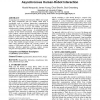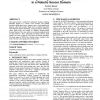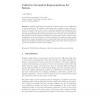2972 search results - page 3 / 595 » Representing the Knowledge of a Robot |
SPATIALCOGNITION
2000
Springer
14 years 1 months ago
2000
Springer
An approach to high-level interaction with autonomous robots by means of schematic maps is outlined. Schematic maps are knowledge representation structures to encode qualitative s...
IROS
2007
IEEE
14 years 4 months ago
2007
IEEE
— Humans have at some point learned an abstraction of the capabilities of their arms. By just looking at the scene they can decide which places or objects they can easily reach a...
HRI
2009
ACM
14 years 4 months ago
2009
ACM
An ongoing issue in human robot interaction (HRI) is how people and robots communicate with one another. While there is considerable work in real-time human-robot communication, f...
ATAL
2005
Springer
14 years 3 months ago
2005
Springer
2. THE MASM ALGORITHM An input to the MASM algorithm is a time-annotated multi-agent action sequence. The action sequence is then transformed into an action graph. An action graph ...
DARS
2000
Springer
14 years 2 months ago
2000
Springer
Realistic applications of autonomous Robotics face a lot of difficulties in real environments. To navigate, self-localize and cooperate in such contexts, a multi-robot system has t...



